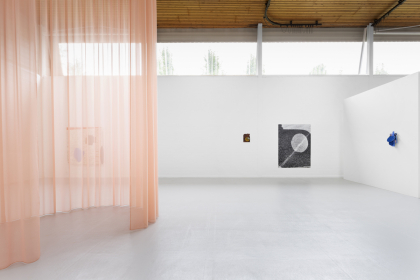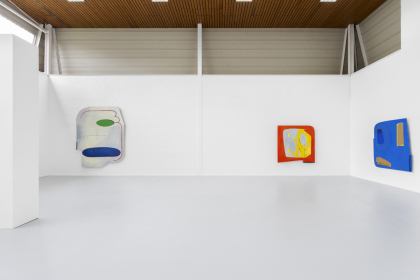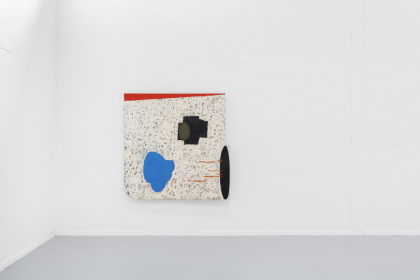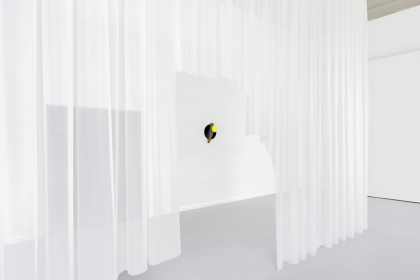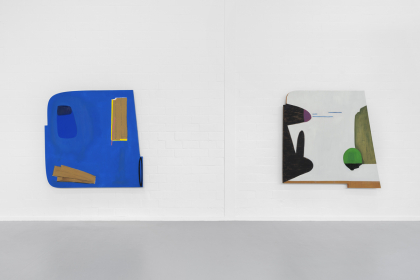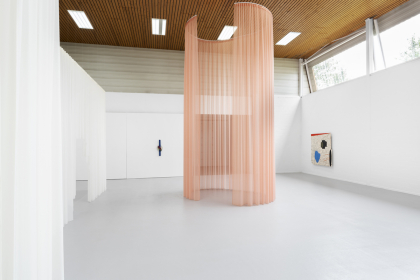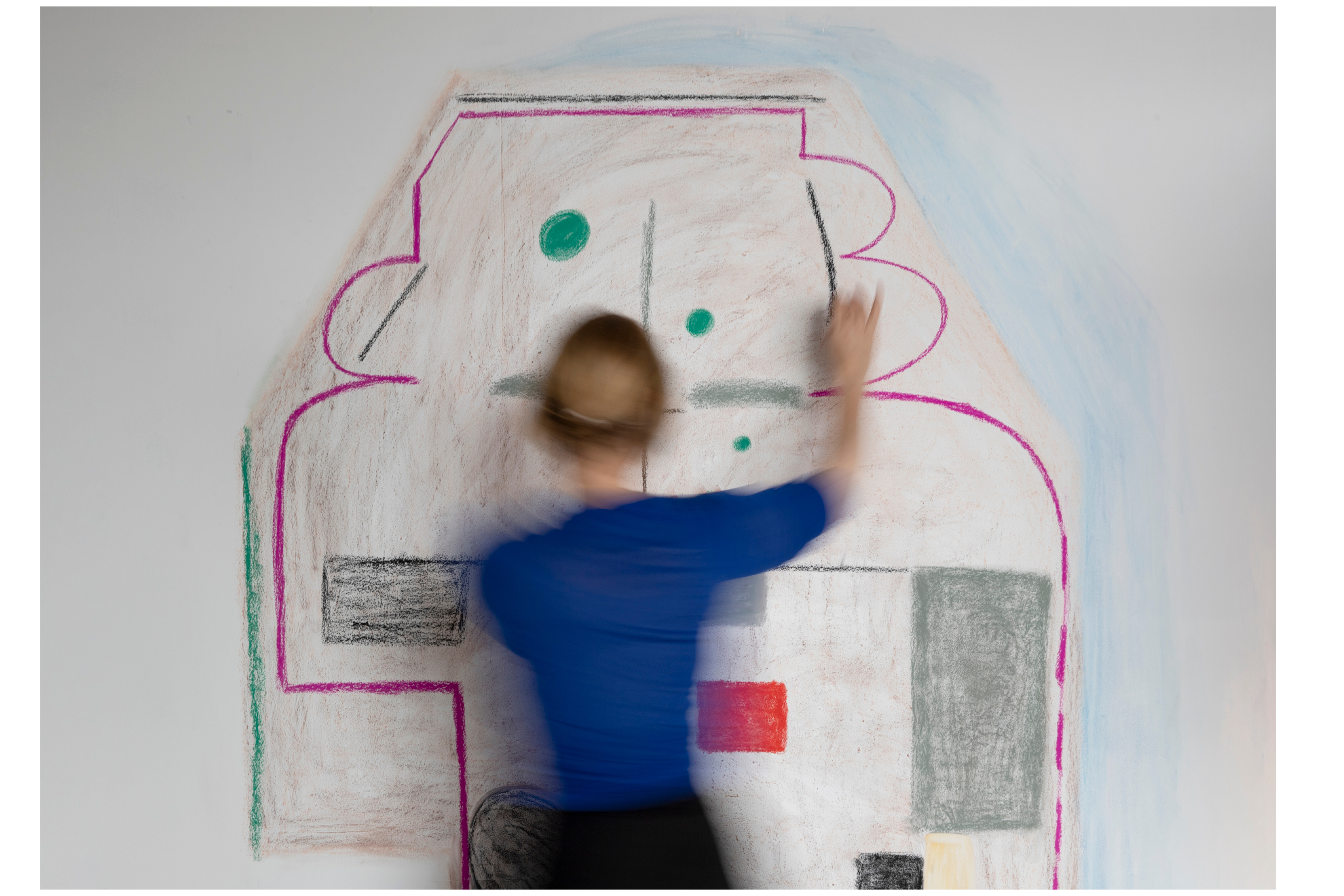
ROADRUNNER BOOGIE
Joke Hansen
With each new painting or series, Joke Hansen sets ground rules for herself. For example: at least one oblique plane, at least one eye and no more than two corners. In recent years, she has made this game of strangely shaped canvases and cut-outs her own, and it constantly directs her towards new quests.
Like any painter, she displays an urgency to break out of the confines of the canvas. Her solution is to look for alternative forms: roundings, angled sides and cut-outs. The cut-outs and, in parallel, the oval-, circular- or elliptical-shaped elements on the canvas imply an extra dimension, a portal to another world or a next level. Occasionally, this in-out movement is enhanced by, for example, rays that seem to shoot out of a passageway.
On the canvases themselves, besides the dimension-implicating entry points, there is a quest for the foundations of painting. Like any painter, Hansen also finds herself confronted with questions of colour, light, composition, perspective and brushwork. Each new work clashes with a delicate balance between resolving unpleasant compositional tensions and finding just enough interesting friction. For instance, a certain volume may evoke an association with shadow, but is it? How is a painterly shadow supposed to function? As in some cartoons, shadows in her work take an unrealistic, abstracted form, but they do offer a perspective, or at least a certain viewing direction.
The character Roadrunner from Looney Tunes is a notorious escape artist. He eludes any attempt to catch or overtake him, with his speed as well as his shrewdness. Wherever he is, there will be running, tumbling, jumping and falling. Inevitably, the flashy images work on our laughing muscles, partly stimulated by the soundtrack. Hansen's works have been described in the past as onomatopoeic, sound imitations. Here and there, the paintings buzz, shoot, flash and pop, almost like a contemporary, non-verbal answer to pop art. But what really matters is not so much the sound itself, as the suggestion of rhythm and movement.
This magic music grooves me, that dirty rhythm fools me
The devil's gotten to me through this dance
I'm full of funky fever, a fire burns inside me
Boogie's got me in a super trance
The Jacksons, Blame it on the Boogie
She herself often describes the dancing holes, tubes and tunnels in her work as escape routes. Think of a play mat for children, in which different perspectives are combined to form a visually attractive whole, or a game like Super Mario Brothers, in which different levels repeatedly evoke new worlds where dangerous corridors, narrow bridges or treacherous courses must be conquered. Typically, games set in two dimensions look for ways to still evoke a third dimension, for instance by switching perspectives or combining cross-sections.
In the new series Lost and Found, she reverses her cut-outs. The same elements that are cut out in her larger works are assembled and condensed into sculptural volumes, playing equally with layers and perspective; less because of an essential reduction and more in favour of a mass; not in paint, but in a third dimension. Neither the finding nor the stacking of these elements happens strategically. Everything is intuitive and spontaneous, like fantastic convulsions on the disco dance floor. As in her painted canvases, of which spontaneous actions also form the basis, artistic delight spills out.
The essence of a completely fictional escape route in Shuffling Bob (inspired by the floor plan of a prison) steers the gaze as abstract linework. While Hansen's concern does have to do with seeking an escape from a 'trapped' situation (be it a cell or a canvas), her works are anything but scary or dark. We are not in a frightening free fall, but rather making a curious leap into the unknown. She rarely takes us all the way to that other universe, but lets our imagination play in the gravity-free in-between dimension of corridors and tunnels leading to it, with a rhythm, danceability and optimism not inferior to Mondrian's Victory Boogie-Woogie.
The absorbing pull of tunnels and holes, and therefore acceleration or deceleration, of falling and jumping, takes us off balance. Suddenly, the ground under our feet is not so stable. The perspective changes and wobbles, as it can only do in a metaverse or dream world. The gravity we take for granted, which defines the relationship between our bodies and the materiality of the canvas against the wall, is momentarily shaken. Our perception, our certainty about what is real and what is not, our role as mere 'viewers' (or are we participants?) comes into question.
For the first time, in collaboration with scenographer Joris Perdieus, Hansen translates this 'boogie' into a spatial experience, which automatically turns the exhibition into a total installation. In a black-and-white blow-up, she enters into a direct dialogue with Raoul De Keyser, but not without tilting the perspective there too. Inspired by Mies van der Rohe, semi-transparent constructions direct the visitor's dance through the room. The curtains echo passageways and portals from the paintings. As in the canvases, we don't know what adventure lurks behind the next corner.
Tamara Beheydt

